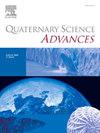外拉布拉多海过去55万年深水潜流变化的重建
IF 2.2
Q2 GEOGRAPHY, PHYSICAL
引用次数: 0
摘要
我们在综合海洋钻探计划(IODP) U1302/1303地点对拉布拉多海外区域进行了55万年的综合多代理分析。我们将新的底栖有孔虫稳定氧(δ18O)和碳(δ13C)同位素记录与沉积物元素组成和自生钕同位素测量相结合,以深入了解深水物质来源和深水西部边界流(DWBC)的变化,该流将北大西洋深水(NADW)出口到更广阔的北大西洋,作为大西洋经向翻转环流的一部分。我们发现,在过去的550年里,拉布拉多海地区可能一直存在着一个突出的DWBC。海洋同位素阶段(MIS) 14 ~ MIS 2的冰峰DWBC持续变弱或变浅,而MIS 13a ~ MIS 1的间冰期DWBC除MIS 7e外均呈增强特征。此外,在这些冰期-间冰期,主要的深水块体从区域性(富钾沉积物,非放射性成因的εNd)到更远的北欧海(富钛沉积物,放射性成因的εNd)。然而,深水物源的这些变化并不总是与DWBC强度相关,这表明在整个地质历史中,其他因素可能在塑造DWBC强度或岩心深度方面发挥了重要作用。本文章由计算机程序翻译,如有差异,请以英文原文为准。
Reconstruction of deep-water undercurrent variability from the outer Labrador Sea during the past 550,000 years
We present a comprehensive multi-proxy analysis spanning 550,000 years from the outer Labrador Sea region at the Integrated Ocean Drilling Program (IODP) Sites U1302/1303. We combine new benthic foraminiferal stable oxygen (δ18O) and carbon (δ13C) isotope records, with sediment elemental composition and authigenic neodymium isotope measurements, to provide insights into deep-water mass sourcing and changes of the Deep Western Boundary Current (DWBC), which exports North Atlantic Deep Water (NADW) into the wider North Atlantic as part of the lower limb of the Atlantic Meridional Overturning Circulation.
We find that a prominent DWBC likely remained a persistent feature within the Labrador Sea region throughout the past 550 kyr. However, glacial peaks of marine isotope stage (MIS) 14 to MIS 2 were consistently characterized by a weaker or shallower DWBC, while all interglacial periods of MIS 13a to MIS 1, with the exception of MIS 7e, were marked by enhanced DWBC. Additionally, the dominant deep-water masses feeding into the DWBC during these glacial-interglacial periods varied from regional (K-rich sediment, unradiogenic εNd) to more distal sources from the Nordic Seas (Ti-rich sediment, radiogenic εNd). Yet, these changes in deep-water provenance did not consistently correlate with DWBC strength, suggesting that additional factors may have played a significant role in shaping the DWBC strength or core depth throughout the geological past.
求助全文
通过发布文献求助,成功后即可免费获取论文全文。
去求助
来源期刊

Quaternary Science Advances
Earth and Planetary Sciences-Earth-Surface Processes
CiteScore
4.00
自引率
13.30%
发文量
16
审稿时长
61 days
 求助内容:
求助内容: 应助结果提醒方式:
应助结果提醒方式:


